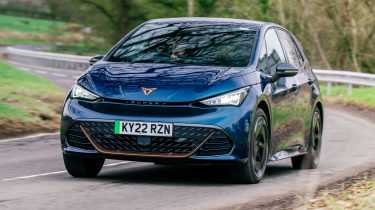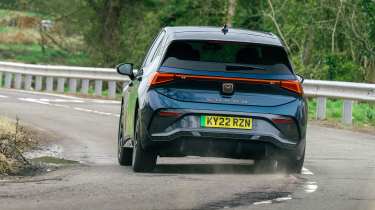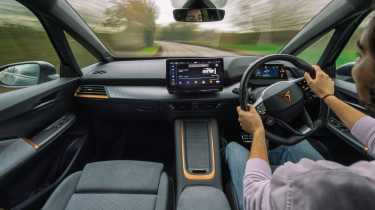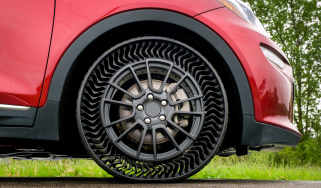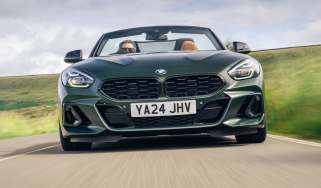Cupra Born Fast Fleet test – eight months in Spain's warm electric hatch
Did our electric hatchback convince us we don’t need to cling on to internal combustion?
We posed a very simple question when the Cupra Born arrived on the evo Fast Fleet eight months ago, namely: is the Born the first all-electric hot hatchback? If you’ve been following our reports you may already have a sense of what our answer to that question is.
As a refresher, the Born 230 V3 is the flagship of the range, featuring a 228bhp tune for its electric motor, plus extras such as 20-inch wheels and electric seats. Our car also had the larger 77kWh battery (£2770), along with Aurora Blue metallic paint (£840) and the ‘Tech Pack L’ (£740 and including auto parking, wireless phone charging and a proximity key). These options took the 230 model’s base price of £39,205 up to £43,555.
> Toyota GR Supra 2.0 Fast Fleet test – six months in the four-cylinder Porsche Cayman rival
The Born’s bespoke EV architecture places its batteries on a flat plane beneath the cabin, with the motor mounted on the rear axle, making it rear-wheel drive. Can you explore its limits of grip? Sort of, if you’re slow into a corner, turn in early and get on the throttle before the apex, but generally there’s very little leeway in the traction and stability systems.
More reviews
It’s also not a particularly fast car, as while the power figure might suggest near warm-hatchback performance, the 1906kg kerb weight (on our scales, compared with Cupra’s claim of 1875kg) gives it a power-to-weight ratio of 122bhp per ton – or slightly less than that of a Cupra Leon 190 with the 187bhp 2-litre petrol engine. So it’s no firecracker in a straight line, even with the electric motor’s instant access to full power and torque.
So no, the Born isn’t an electric hot hatchback. But what’s it like as a daily-driven EV runabout? In this context, the outlook is brighter. The first thing to mention is the impressive range. We often saw up to 280 miles from a full charge in mild weather, reducing to 220 miles in colder conditions. (The official WLTP ‘combined’ range is 335 miles.) This equates to over 3.6 miles/kWh in those favourable circumstances, dropping to around 2.8 in cooler temps – pretty good results compared with the Born’s EV rivals, so there’s one box ticked.
The powertrain is also extremely refined and has one of the best throttle and brake calibrations I’ve yet experienced in an EV. The ‘active’ energy recuperation, which varies regenerative braking levels based on the traffic, isn’t so clever, mind. No doubt there’s a market for it, but I just couldn’t stand constantly having to second-guess how much regen would be automatically applied. The alternative is to drive the car in its high-regen ‘B’ mode – as I did – and adopt a (near) one-pedal driving style.
The exasperating user interfaces had no workable alternatives, though. Needing to press four layers of touchscreen buttons just to turn on the heated seats or switch off the irritating lane-keep assist was never not annoying. The same could be said of the lack of illumination for the volume and temperature touchbars when driving at night.
But there was one overarching problem that outweighed these niggles. Despite the vast amount of money the VW Group is pouring into the development of its electric cars, the MEB platform, on which the Born is based, feels unfinished, and this manifests itself in the way the car drives. Body control could be found lacking, the suspension sometimes running out of travel. At the same time the ride was very poor, rarely feeling truly settled. At low speeds over rough roads the high seating position relative to the car’s roll centre gave occupants a jack-in-the-box feeling of being wobbled from side to side in the cabin. The car was also oddly unstable under hard braking, which perhaps explains why its stability system had been given such a firm grip. Ultimately, it felt like a package in need of further refining.
But let’s get something straight. The hamfisted legislation being put upon car makers to electrify as quickly as possible has forced them into an impossible situation. They can’t hold out too long before switching to electric, otherwise they’ll be throwing money away developing a condemned technology. Cupra has made its first brave leap. At the same time, manufacturers still need to make money from the cars they build, yet the cost of the batteries remains high. So savings need to be made elsewhere, especially on more affordable EV models, which could explain some of the Born’s more disappointing aspects.
So perhaps a fairer question to ask is whether the Born is a good EV, all things considered? The answer to that is yes, but we’re certain there’s better yet to come.
| Date acquired | August 2022 |
| Duration of test | 8 months |
| Total test mileage | 5857 |
| Overall mi/kWh | 3.5 |
| Costs | £0 |
| Purchase price | £43,555 |
| Value today | c£27,000 |
This story was first featured in evo issue 310.

